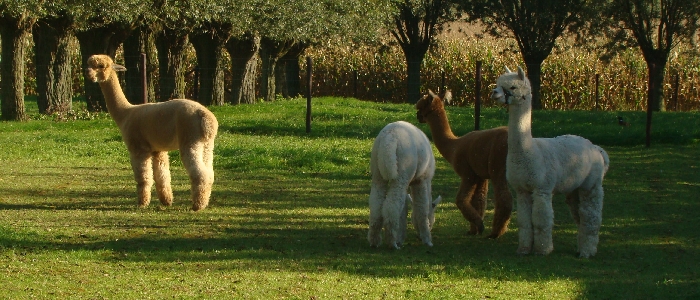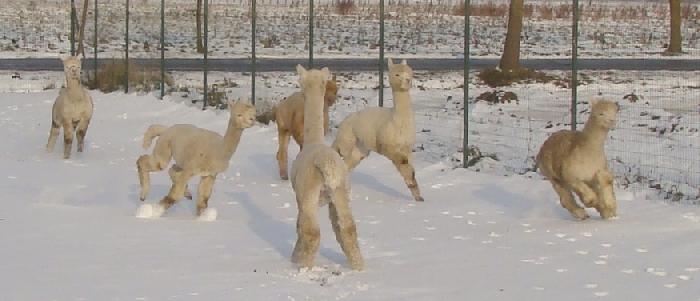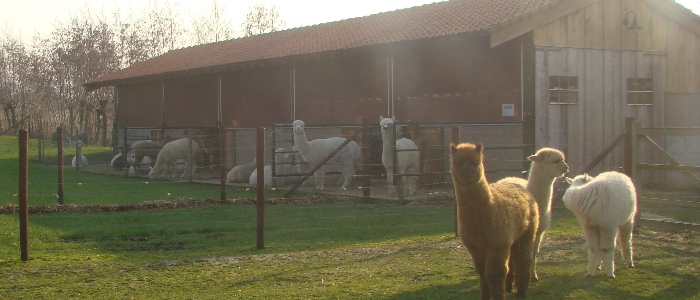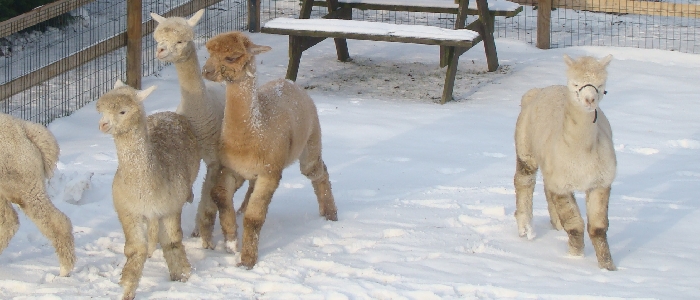Voedingsvereisten
ALPACA NUTRITIONAL REQUIREMENTS
By Nic Cooper, Southern Alpacas Stud
Alpacas are quasi-ruminants with three stomachs. They chew just enough to mix their feed with saliva to form a bolus to be swallowed. While resting, the alpaca will bring up a bolus and chew it, then it is swallowed again. It takes about a third of daylight hours for an alpaca to pick enough food.
When we feed alpacas we are actually feeding the bugs in their stomach, which in turn process the food to feed the alpaca. There are hundreds of species of bacteria and protozoa in the alpaca digestive system.
Making any dietary changes should be done slowly, with changes of feed introduced gradually, as the micro fauna and flora are sensitive to change.
We need to feed protein to the bugs in the alpaca first stomach. The bugs are crucial to the fermentation process. The bugs excrete high quality amino acids to be absorbed by the third stomach compartment (C3) of the alpaca.
The critical nitrogen balance in alpacas is very efficient, as they recycle urea through saliva, and return it to the C1 and C2 parts of the stomach. Urea is utilised by the stomach micro-organisms for the synthesis of protein.
PROTEIN
As a rule of thumb, the greener the pasture, the greater it is in protein - unless it is an artificial fertilizer-driven nitrogen flush.
Alpacas normally require an 8% crude protein diet, which they more than achieve from proper NZ grasses without supplementation.
The situation changes when the dam gets to the latter stages of pregnancy, and also in the first weeks of lactation. At that time a crude protein intake of 12% - 15% is required. This requires the best paddocks, and/or supplementation.
Alpacas need % crude protein Feeding out
Maintenance mode 8%
Lactating 13%
Growth (cria) 15%
Gestation 10%
Late gestation 12%
These crude protein requirements for alpacas at differing stages of their lifecycle should be related to the seasonality of feeds and their characteristics at different times of year.
Pastures differ in crude protein (CP) at different times of the year. The same pasture can be 20% CP in spring, but 6% in summer drought. On 20% CP pasture a maintenance alpaca will add 3kg live bodyweight per month and suffer a detrimental effect on fibre. Free choice grazing with few stock in the paddocks can lead to obesity, just as overfeeding supplement can lead to obesity.
Excess protein can depress carbohydrate uptake. This is particularly true on lush spring pastures which are 80% water. It helps to feed out a low protein, high carbohydrate feed, such as late cut meadow hay, or straw at these times.
ENERGY
Protein requirement is in direct relationship to the need for energy. Energy is sourced from carbohydrates (including sugars), starches, hemi cellulose, and cellulose, through volatile fatty acids from carbohydrate and protein fermentation.
Alpacas have a lower energy requirement than other ruminants due to the extra length of time food stays in their gut (48 - 54 hours vs cow at 24 hrs).
They have a more efficient digestive system and are able to extract more energy from the fibre part of their diet. Most ruminants get energy from cell contents, and generally not from cell walls (hemi cellulose, cellulose and lignin). However alpacas can get some energy from hemi cellulose and cellulose and hence are more efficient digesters of all food.
The alpaca’s energy requirement depends on environmental conditions (cold or heat stress requires more energy), activity levels, and animal insulation (hide thickness, length of coat, coat condition -- wet, dry, muddy etc).
Their stocking rate at maintenance = 1.5 x for sheep.
(alpaca = 0.65 - 0.70 of a standard stock unit)
FIBRE
Fibre, of the feed kind, is essential for the proper functioning of the fermentation vat.
All fibre intake needs to be long stem fibre - at least 25% should be greater than 4 cm long to allow "scratch factor" for proper breakdown of the fibre within the stomach.
This fibre is NOT the stems - that are left uneaten - but the leaves that are eaten. No scratch factor can lead to acidosis and ulcers.
VITAMINS
A, D and E are all required.
A and E will normally be supplied through green feed.
Extra E may be needed in young cria being fed hard feed or hay.
B1 (Thiamine) and B12 should be supplemented at times of stress and fermentation disorders.
D supplementation may be required - see our article on Vitamin D
MINERALS
Supplement the soil, and the feed, rather than supplementing the animal directly by needle or direct dosing.
We recommend doing a soil test of your property. The soil provides the minerals to the pasture plants and grasses, which provides the minerals to the alpaca. The key is in the balance of minerals in proportion, not just the absolute values, as minerals interact and suppress.
Your alpaca can get these minerals from its grass and hay, or from supplements.
You can get your forage (grass and hay) analysed and this will tell you how much is available from there. Normally however in NZ farming conditions very little trace mineral is available from the soil and grasses as fertilizer and pasture practices have drained the trace minerals from the soils.
WATER
Start with fresh, clean, high quality water that is always available. Keep your troughs clean. If you would not drink out of your troughs, or drink the water in there, then neither should the alpacas !
In winter frosts in the south, break the ice on the trough in the morning.
You can test your water to determine: pH, salinity, hardness, microbiological culture, and contaminants.
Alpacas need drinking water and they get water from moisture in their feed, and water produced by oxidative processes associated with energy metabolism. Lush pasture provides a lot of water, whereas dry feed has little water and alpacas on dry food require more water intake.
Alpacas lose water through urine, milk, perspiration, and evaporation. If an alpaca produces more of these fluids, they need more water. Sufficient water is critical to milk production in the dam.
Alpacas will drink:
5% -- 8% body weight at maintenance
10% -- 15% in hot humid weather or if lactating.
An alpaca weighing 68 kg will consume 5.5 kg of water per day (maintenance) and 10.2 kg/day (lactating or in hot weather).
N.B. Water Conversions 0.5 ltr=0.5 kg 2000 litres = 1 cu mtr
Alpaca Daily Feed Requirement
Feed requirements are usually quoted in dry matter. The amount fed will depend upon the moisture content of the food eaten. Hay has a water content of 10-12%, whereas grass and pasture has 50-75% water content.
In drought/winter with 80% dry matter in feed, an alpaca needs only 1.3 kg intake.
In spring with 20% dry matter in forage, an alpaca needs 4.5 - 5 kg intake daily. Those lush looking spring pastures are more water than anything else, and you need to feed out hay as well.
Based on %DM and ppm levels for a pregnant female weighing 68kg consuming dry matter at a 1.5% of bodyweight per day (lactating) level, then 1kg of dry matter food has to be eaten.
Nutrient Content
Requirement
Expected Intake (DM) 1.0 kg
Crude Protein 105.5 gm
Calcium 4.1 gm
Phosphorous 2.4 gm
Potassium 10.2 gm
Magnesium 1.5 gm
Salt 5.6 gm
Cobalt 0.27 mg
Iodine 1.0 mg
Copper 11.5 mg
Iron 51 mg
Manganese 48 mg
Selenium 1.0 mg
Zinc 48 mg
Vit A 3,375 IU
Vit D 2,045 IU
Vit E 33.75 IU
Deduct the above requirement from what you get from your forage supply and you can then check the shortfalls against what you feed daily in supplements. Ideally you should be using a supplement that totally fills the gap, and ensure intake that also fills the gap.
Shortfall make up (for each element) = quantity in kg of supplement X amount in Kg consumed
[2009-02-23 door Nic Cooper]







